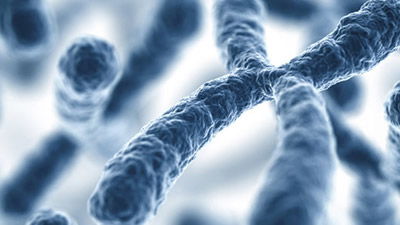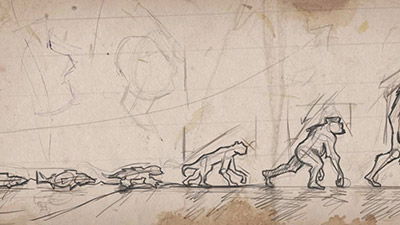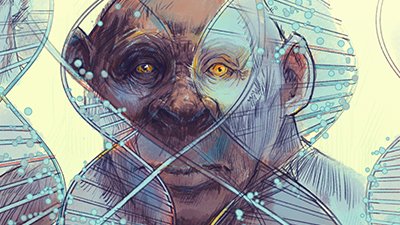
Scars of Evolution or of a Sin-Cursed World?
“Scars of evolution,” a series at February’s meeting of the American Association for the Advancement of Science, featured speakers explaining how human evolution has produced an inferior product.
News Source
- ScienceNOW: “Human Evolution: Gain Came With Pain”
Speakers covered the un-wisdom of having wisdom teeth (which we recently discussed), fumed about the foot’s failures, bemoaned the back-aching consequences of bipedalism, and belabored childbirth.

“Scars of Evolution” was a series of presentations at the February meeting of American Association for the Advancement of Science. Speakers indicated our physical frailties are evidence that we were not designed but evolved from ape-like ancestors. Image credit: adapted from www.bu.edu.
Ultimately, “Scars of Evolution” attributed the physical problems humans have to the limitations imposed by the necessity of working with the already-evolved material in ape-like ancestors. As anthropologist Matt Cartmill explained, “Evolution doesn’t ‘design’ anything” because it must slowly work on the genes and traits it has available, adding, “Evolution doesn’t act to yield perfection. It acts to yield function.”
Anthropologist Jeremy DeSilva, in “Starting Off on the Wrong Foot,” alleged that the human foot is a poor modification of a tree-climber’s foot. “Given that the modern human foot functions primarily as a stable platform and a propulsive lever, it is far from ideal that the anatomical precursor was a mobile, grasping appendage,” according to DeSilva. “But, because we are primates, and natural selection tinkers with pre-existing structures, the transformation of a flexible, grasping foot to a stiff propulsive lever is precisely the evolutionary legacy of our foot and ankle. The evoltion of a stable structure from a grasping one has left us particularly susceptible to a variety of foot and ankle injuries.”1

Each step consists of steps to which the foot adjusts. (1) During the initial phase of a step, the heel-strike unlocks the rigid arrangement of bones in the foot/ankle complex, allowing them to become loose and responsive to movements in the leg. Thus the entire leg is able to help the foot absorb the shock of the step. (2) The slightly loosened bones are able to slide into optimal positions to remain stable as the foot dynamically adjusts to bear the weight of the body despite uneven surfaces and continuously changing force vectors. After midstance, the foot’s bones shift in response to joint rotations in the leg and ankle into a more rigid arrangement. (3) Dorsiflexion of the foot tightens the plantar fascia to lock the bones into a rigid lever that can rock to propel the body’s weight forward. Image credit: https://web.archive.org/web/20130308182252/http://www.oandp.org/olc/lessons/html/200606-14/section_5.asp
DeSilva explained, “This anatomy isn’t what you’d design from scratch.” Noting the foot has 26 bones, he said, “You wouldn’t design it out of 26 moving parts. The foot was modified to remain rigid. A lot of BandAids were stuck on these bones.”
DeSilva notes the ostrich foot and leg are fused and only have two toes. “Why can’t I have a foot like that?” he says. DeSilva’s simplistic wish for a rigid foot hinges on the idea that with fewer moving parts there should be less friction-wear and fewer ways to inadvertently twist or break. Yet the prosthetic industry seeks ways to imitate the human foot’s excellent design to perfect their products for the handicapped.
The human foot’s 26 bones are strapped together and actuated by numerous ligaments, tendons, fascial planes, and muscles in order to achieve a dynamic design that actually changes its characteristics from moment to moment in every step. The American Academy of Orthotists and Prosthetists2 notes that the human foot works in synchrony with the hip and the entire leg as it transforms from being flexible and springy during the first part of a step to a rigid lever able to bear and transfer the body’s weight. Even when the foot becomes more rigid, its arches continue to function as shock absorbers and adapt to uneven surfaces.
The loosely arranged components of the foot and ankle complex enable it to remain stable while adjusting to weight transferred from the other foot. As the direction and magnitude of force (weight) change, the joints and bone alignment in the foot and ankle gradually shift. Through interaction with subtle joint rotations in the leg and ankle, the bones begin to lock into place. As the ankle bends (dorsiflexes), tension in the tough plantar fascia (a sheet of connective tissue on the bottom of the foot) steadily draws the bones into a locked position. The foot and ankle are thus transformed into a tightly packed, rigid structure. Yet if the foot were rigid throughout the entire step, it would be unable to make the dynamic adjustments needed for stability during the first portion of a step.3
Anatomist Bruce Latimer blames back problems on evolution’s inability to cope with human bipedality.
Anatomist Bruce Latimer blames back problems on evolution’s inability to cope with human bipedality. Comparing our back to a stack of cups and saucers with a heavy dictionary resting on top, he says, “If you are really careful, you can balance it — otherwise there's a lot of porcelain on the ground. Then imagine taking this and putting in all the curves that you naturally have in the spine. I could give you all the duct tape in the world, and you still couldn't possibly balance it.4 Additional blame for stress on vertebral discs accrues to the repetitive “twisting motion”5 the swinging human gait imposes on the back, he says. Latimer considers the human back to be “cobbled together with duct tape and paper clips.”
Despite the erroneous comment in the ScienceMag.com article that the lordotic (lower back) curve developed “so as not to obstruct the birth canal,” humans are not born with all the curves the back eventually develops. Secondary curves like the one in the lower back develop primarily in response to an upright posture during normal human development. They are not a millions-of-years evolutionary adaptation. This curve helps our balance by shifting our center of gravity over the hips and stabilizing the lower back. The back’s S-shape also provides a springy protection for the spine. Latimer claims that scoliosis, spontaneous vertebral fractures and those due to trauma, and herniated discs resulted from “turning a spine originally adapted for a quadruped into one that is perpendicular to the ground.”6
The conditions that Latimer mentions are not design flaws. They are unfortunate consequences of living in a sin-cursed world. Scoliosis, for instance, is thought to be a multigene dominant defect.7 And spontaneous vertebral fractures, though they are unique to humans because we are bipedal, are predominantly the result of osteoporosis in older people and hereditary disorders in the young. They are not a consequence of our uniquely S-shaped spine. Though Latimer derides normal arm-swinging walk of humans for causing wear-and-tear on our intervertebral discs, the fact that our bodies wear out does not condemn the original design.

The shapes and arrangement of the foot’s 26 bones, bound with ligaments, tendons, muscles, and the plantar aponeurosis (fascia), make it possible for the foot to morph between a flexible yet stable adjustable weight-bearing platform (early in each step) and a rigid foundation for propulsion into the next step. Plantar fasciitis, a painful inflammation, is particularly annoying because the plantar fascia draws the loosened bones together as the ankle dorsiflexes. Image with additional information about the causes and treatment of plantar fasciitis are at www.ncbi.nlm.nih.gov
Anthropologist Karen Rosenberg suggests that obstetrics provides strong evidence that we evolved. She said, “If you want to look for examples of how we're not the result of intelligent design, you don't have to go far — just look at the complicated, uncomfortable way we have babies. .&bsp;. . If an engineer were given the task to design the human body, he or she would never have done it the way humans have evolved. Unfortunately, we can't go back to walking on four feet. We've undergone too much evolutionary change for that — and it is not the answer to our problems.”8
Yet the human pelvis is ideally designed to balance the demands of walking upright and bringing a baby with a large head into the world. Unlike a quadruped, our pelvis must tilt to create anatomy suitable for genuine bipedalism while keeping our organs suspended in defiance of gravity. The bones of the pelvis provide attachment points for rings and slings of muscles and connective tissue that keep our “insides” from falling out as we walk. Yet those bony prominences are arranged to create, not a gauntlet, but a path to guide the newborn through a series of rotations to a safe and successful exit.
The pelvic bones and muscles tend to bend and twist the baby in the direction of least resistance even as that direction continually changes. These structures cause the head—somewhat streamlined due to its unfused bones—to turn to allow the smallest dimension to enter the curvy birth canal at each level. Even in the face of individual pelvic variations and baby sizes, there is usually a route that will work.
Like the rest of the things about our bodies that can go wrong, childbirth doesn’t always occur as it should, yet for about 6,000 years the mechanism God designed has functioned nicely, albeit with the pain incurred as a result of Eve’s rebellion as described in Genesis chapter 3.
The real villain, from an evolutionary point-of-view, is human bipedality. Evolutionists attribute an ape-like ancestor’s opportunity to evolve upward to the fact it learned to walk upright. Anatomical features that make bipedality normal and natural for us, like anything else in our bodies, can wear out. These conference speakers say they wear out because they couldn’t evolve in a better way from ape-like raw material. The argument is very convenient, but it proceeds from the flawed and scientifically unverifiable presumption that we evolved from ape-like ancestors in the first place.
The real villain, from an evolutionary point-of-view, is human bipedality.
Creationists and intelligent design proponents find ready examples of God’s marvelous design in the human body. Anatomical intricacies creatively combine functional features in masterpieces of biological engineering. A recent spate of articles in the popular press, like these presentations, allege humans lack evidence of design. The assumption is that if something goes wrong, then it couldn’t have been designed—leaving God out of the picture and clearing the floor for evolution’s case. Some even imply that God must be a poor Designer because our bodies can malfunction. Of course, expectations for an evolutionary product would be considerably more forgiving than those demanded of God.
Yet that is not how things really work. God did, by His own account, create a perfect world devoid of evil and suffering. The Bible explains that suffering and death entered the world as a consequence of man’s sin and rebellion.9 As a consequence of human rebellion, people get sick, wear out, suffer traumatic injuries, and die. The fact an anatomical design or physiological process can have things go wrong or has limitations in the present sin-cursed world does not demonstrate that it wasn’t designed perfectly in the first place.
Further Reading
- Organ Recital: A Parade of Presumed Design Flaws Devoid of Truth
- Why Does God’s Creation Include Death and Suffering?
- Modern People Can Climb Trees, Why Not Lucy? (Lucy’s ups and downs/dorsiflexion of the human foot)
- The Evolution of Childbirth?
- Understanding the Answer in Genesis 3:16 (pain in childbirth)
- Is It Wrong to Interfere with the Pain of Childbirth?
- Tie of Human Pregnancy to Bipedality Becomes Extinct (evolution of childbirth)
- Are Wisdom Teeth (Third Molars) Vestiges of Human Evolution?
- Is Lack of Room for Wisdom Teeth Proof of Evolution?
- The Appendix: Useless Vestige or Evolutionary Innovation? (the oft-evolved appendix)
- The Human Vermiform Appendix
- The Seeing Eye
- The Hearing Ear
- This information is intended for general education purposes only and is not intended as professional medical advice. The information should not be relied upon as a substitute for medical advice from your doctor or other healthcare professional. If you have specific questions about any medical condition, diagnosis, or treatment, you should consult your doctor or other healthcare provider.
For More Information: Get Answers
Remember, if you see a news story that might merit some attention, let us know about it! (Note: if the story originates from the Associated Press, FOX News, MSNBC, the New York Times, or another major national media outlet, we will most likely have already heard about it.) And thanks to all of our readers who have submitted great news tips to us. If you didn’t catch all the latest News to Know, why not take a look to see what you’ve missed?
(Please note that links will take you directly to the source. Answers in Genesis is not responsible for content on the websites to which we refer. For more information, please see our Privacy Policy.)
Footnotes
- Jeremy DeSilva, “Starting Off on the Wrong Foot,” AAAS, February 15, 2013, aaas.confex.com/aaas/2013/webprogram/Paper8518.html.
- Paul E. Leimkuehler, “Section 3: Human Foot and Ankle Versus Prosthetic Foot/Ankle MEchanism Function,” American Academy of Orthotists & Prosthetists, https://web.archive.org/web/20130308182252/http://www.oandp.org/olc/lessons/html/200606-14/section_5.asp.
- For more information, see Leimkuehler, “Human Foot and Ankle” and L. A. Bolgla and T. R. Malone, “Plantar Fasciitis and the Windlass Mechanism: A Biomechanical Link to Clinical Practice,” Journal of Athletic Training39, no. 1 (Jan–Marc 2004): 77–82; www.ncbi.nlm.nih.gov/pmc/articles/PMC385265.
- Charles Choi, “Aches and Pains: You Can Thank Evolution for Them,” Yahoo! News, February 15, 2013, news.yahoo.com/aches-pains-thank-evolution-them-033637391.html.
- Ibid.
- DeSilva, “Starting Off on the Wrong Foot.”
- B. V. Reamy and J. B. Slakey, “Adolescent Idiopathic Scoliosis: Review and Current Concepts,” American Family Physician, 64, no. 1 (July 2001): 111–117; www.aafp.org/afp/2001/0701/p111.html.
- Ibid.
- See “Suffering & Death” and “Why Does God’s Creation Include Death and Suffering?”

Answers in Genesis is an apologetics ministry, dedicated to helping Christians defend their faith and proclaim the good news of Jesus Christ.
- Customer Service 800.778.3390
- Available Monday–Friday | 9 AM–5 PM ET
- © 2026 Answers in Genesis



